Archive for the ‘Uncategorized’ Category
Tuesday, July 15th, 2008
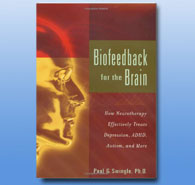 I was delighted to be able to review this book prior to its recent publication. It is one of the few in recent times to introduce the public to neurofeedback / EEG biofeedback. Paul Swingle is a seasoned biofeedback practitioner, well-known within the field through conferences and workshops. Swingle was for many years the coordinator of psychophysiology services at Boston’s McLean Hospital, and lecturer in psychiatry at Harvard. He is currently active in private practice in Vancouver, Canada. This is the first time that his somewhat eclectic approach has been thoroughly described within one accessible resource. I was delighted to be able to review this book prior to its recent publication. It is one of the few in recent times to introduce the public to neurofeedback / EEG biofeedback. Paul Swingle is a seasoned biofeedback practitioner, well-known within the field through conferences and workshops. Swingle was for many years the coordinator of psychophysiology services at Boston’s McLean Hospital, and lecturer in psychiatry at Harvard. He is currently active in private practice in Vancouver, Canada. This is the first time that his somewhat eclectic approach has been thoroughly described within one accessible resource.
The book will appeal to both mental health professionals and to the interested public. Health professionals will find it a useful introduction to how Swingle works with clients using both neurofeedback and complementary modalities. Its main appeal will be to parents and to other potential clients. Swingle proceeds with a focus on Attention Deficit Hyperactivity Disorder, even though he largely downplays the issue of diagnosis. ADHD has become a common label that is being applied to a heterogeneous spectrum of conditions. By now it is setting the terms of discourse for everyone. The book will nevertheless be sought out by parents with a variety of other behavioral, attentional, and learning issues with their children. (more…)
Posted in Uncategorized | No Comments »
Friday, July 4th, 2008
Untitled Document
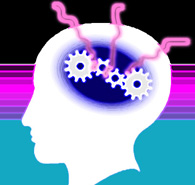 The seemingly never-ending controversy about the validity of QEEG discriminant functions came up again recently, this time in connection with traumatic brain injury. If a TBI discriminant function is to have validity, then the problem of false negatives and false positives better be a small one. But when it comes to traumatic brain injury, how do we ever know whether a case assigned to the bin of false positives is anything of the kind? Perhaps we are dealing with a case where traumatic brain injury occurred but was not registered as such. Birth injury is a case in point. The seemingly never-ending controversy about the validity of QEEG discriminant functions came up again recently, this time in connection with traumatic brain injury. If a TBI discriminant function is to have validity, then the problem of false negatives and false positives better be a small one. But when it comes to traumatic brain injury, how do we ever know whether a case assigned to the bin of false positives is anything of the kind? Perhaps we are dealing with a case where traumatic brain injury occurred but was not registered as such. Birth injury is a case in point.
Then there is the matter of false negatives. Those who have worked with minor traumatic brain injury over the years are aware that symptom severity does not match up well against the apparent severity of the insult. Even apparently minor whiplash in a low-speed fender bender can leave someone dysfunctional. One of my favorite cases along these lines involves an attorney whose job it was to discredit head injury cases before juries on behalf of his employer, an insurance company. While he was out at a restaurant he visited the men’s room just as the light bulb burned out there and left him in the dark. He thought he knew his way around, but ended up hitting his head on a stall partition. He returned to the table, finished his dinner with his guests, and got back home safely. But he never worked again (until he had done some neurofeedback later). He could no longer organize and plan his work. His edge as a trial attorney was gone. He realized that he was suffering all of the symptoms that he had been ridiculing and diminishing in court for all these years. Suddenly head injury was only too real for him. (more…)
Posted in Uncategorized | 4 Comments »
Wednesday, July 2nd, 2008
Untitled Document
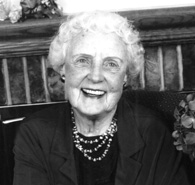 The death of Edwina Froehlich on June 8 brought the La Leche League back into the news. Froehlich had been one of the founders of the group, and the organization was run out of her home for years. It occurred to me on reading her obituary that this group’s experience had some elements in common with ours in biofeedback, and their success may even have laid the groundwork for our success decades later. The death of Edwina Froehlich on June 8 brought the La Leche League back into the news. Froehlich had been one of the founders of the group, and the organization was run out of her home for years. It occurred to me on reading her obituary that this group’s experience had some elements in common with ours in biofeedback, and their success may even have laid the groundwork for our success decades later.
The climate of the day, back in 1956, was of an onrush of modernism that needed to be embraced. Doctors were among the many who were pointing the way to the future. It was not difficult to pitch infant formula as part of that liberating modernism, with the suggestion that it was even superior to mother’s milk. Those who resisted these trends were easily dismissed as old-fashioned and radical to boot. It was not a radical age, despite the fact that radical change was happening. (more…)
Posted in Uncategorized | No Comments »
Thursday, June 26th, 2008
Untitled Document
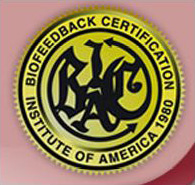 The BCIA is currently polling members on the issue of whether certain designations should be trade-marked by the BCIA in order to set it apart from other claimants. This is an issue that might well be discussed more openly before an organizational decision is rendered. The BCIA is currently polling members on the issue of whether certain designations should be trade-marked by the BCIA in order to set it apart from other claimants. This is an issue that might well be discussed more openly before an organizational decision is rendered.
One issue that concerns me is that trademarking is intended to preserve a zone of exclusivity for commercial enterprises that have a commercial interest to protect. A certifying agency can lay claim to exclusivity simply by virtue of the function they serve. As consumers we all benefit from having a number of oil companies out there looking for our business, but as professional consumers each of us has a need for only one certifying organization in neurofeedback.
The only reason more than one certifying organization would survive over the long term is that different niches of the market are being served. And if there are indeed different niches of the market to be served, then any exclusivity or preference should result from a better match to market requirements, not from entitlements. The BCIA already has the advantage of being the sister organization of the AAPB, even though there cannot be any ‘formal’ connection between them. If the BCIA were to falter going forward, it could only occur by virtue of their policies. (more…)
Posted in Uncategorized | 1 Comment »
Thursday, June 26th, 2008
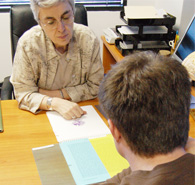 Practice-Based Evidence We know from electoral politics that it is hard to defeat somebody with nobody. In order to push back against the contagion of Evidence-Based Practice it is not enough to “go negative;” one must field a live candidate. We have in fact been living in a world largely driven by Practice-Based Evidence. This is true in particular in the field of neurofeedback, but it is also true in biological psychiatry. The majority of drug use for mental disorders is off-label, and there is essentially no research basis for stacked medications, and very little research on use with children. Actual practice far outruns the available research. This state of affairs is currently being defended by a practicing psychiatrist, David Hellerstein, MD, Associate Professor of Clinical Psychiatry at Columbia University. His message is brief, so here is the whole thing as presented on Medscape: Practice-Based Evidence We know from electoral politics that it is hard to defeat somebody with nobody. In order to push back against the contagion of Evidence-Based Practice it is not enough to “go negative;” one must field a live candidate. We have in fact been living in a world largely driven by Practice-Based Evidence. This is true in particular in the field of neurofeedback, but it is also true in biological psychiatry. The majority of drug use for mental disorders is off-label, and there is essentially no research basis for stacked medications, and very little research on use with children. Actual practice far outruns the available research. This state of affairs is currently being defended by a practicing psychiatrist, David Hellerstein, MD, Associate Professor of Clinical Psychiatry at Columbia University. His message is brief, so here is the whole thing as presented on Medscape:
(more…)
Posted in Uncategorized | No Comments »
Friday, June 20th, 2008
 The AAPB has just published the 2008 edition of its publication “Evidence-Based Practice in Biofeedback and Neurofeedback“, written by Carolyn Yucha and Doil Montgomery. This is an update on the 2004 edition. The new publication spruces up the reference list and adds new material. It now comes to 81 pages, whereas the first one was only 48. Yet there is a lot of commonality between the two versions, with most of the text just carrying over. There have been some steps forward, some steps backward, and some glaring problems persist. The AAPB has just published the 2008 edition of its publication “Evidence-Based Practice in Biofeedback and Neurofeedback“, written by Carolyn Yucha and Doil Montgomery. This is an update on the 2004 edition. The new publication spruces up the reference list and adds new material. It now comes to 81 pages, whereas the first one was only 48. Yet there is a lot of commonality between the two versions, with most of the text just carrying over. There have been some steps forward, some steps backward, and some glaring problems persist.
The first problem I have is with the Alcoholism/Substance Abuse section. Even by their own cramped criteria, the combination of biofeedback and neurofeedback (that is to say, feedback-based self-regulation strategies) meet criteria for ‘Efficacious.’ There is first of all the first Peniston study, and then there is the CRI-Help study. That meets the formal criterion of two independent controlled studies. Multi-year follow-up was done in both of those studies that confirmed the results. These findings were essentially corroborated by the Burkett effectiveness study, in which substantial recovery was documented in the most difficult population imaginable–homeless crack addicts–using alpha/theta training. There is now no doubt whatsoever–none–that a neurofeedback strategy containing Alpha/Theta training contributes to better outcomes in addictions treatment over currently standard treatment. (more…)
Posted in Uncategorized | 2 Comments »
|
|
Subscribe to Email Newsletter
The EEG Info Newsletter circulates via email at least once a month. A variety of topics related to the Neurofeedback / EEG Biofeedback field are covered in over 200 articles.
|
 I was delighted to be able to review this book prior to its recent publication. It is one of the few in recent times to introduce the public to neurofeedback / EEG biofeedback. Paul Swingle is a seasoned biofeedback practitioner, well-known within the field through conferences and workshops. Swingle was for many years the coordinator of psychophysiology services at Boston’s McLean Hospital, and lecturer in psychiatry at Harvard. He is currently active in private practice in Vancouver, Canada. This is the first time that his somewhat eclectic approach has been thoroughly described within one accessible resource.
I was delighted to be able to review this book prior to its recent publication. It is one of the few in recent times to introduce the public to neurofeedback / EEG biofeedback. Paul Swingle is a seasoned biofeedback practitioner, well-known within the field through conferences and workshops. Swingle was for many years the coordinator of psychophysiology services at Boston’s McLean Hospital, and lecturer in psychiatry at Harvard. He is currently active in private practice in Vancouver, Canada. This is the first time that his somewhat eclectic approach has been thoroughly described within one accessible resource.
 The seemingly never-ending controversy about the validity of QEEG discriminant functions came up again recently, this time in connection with traumatic brain injury. If a TBI discriminant function is to have validity, then the problem of false negatives and false positives better be a small one. But when it comes to traumatic brain injury, how do we ever know whether a case assigned to the bin of false positives is anything of the kind? Perhaps we are dealing with a case where traumatic brain injury occurred but was not registered as such. Birth injury is a case in point.
The seemingly never-ending controversy about the validity of QEEG discriminant functions came up again recently, this time in connection with traumatic brain injury. If a TBI discriminant function is to have validity, then the problem of false negatives and false positives better be a small one. But when it comes to traumatic brain injury, how do we ever know whether a case assigned to the bin of false positives is anything of the kind? Perhaps we are dealing with a case where traumatic brain injury occurred but was not registered as such. Birth injury is a case in point. The death of
The death of  The BCIA is currently polling members on the issue of whether certain designations should be trade-marked by the BCIA in order to set it apart from other claimants. This is an issue that might well be discussed more openly before an organizational decision is rendered.
The BCIA is currently polling members on the issue of whether certain designations should be trade-marked by the BCIA in order to set it apart from other claimants. This is an issue that might well be discussed more openly before an organizational decision is rendered. Practice-Based Evidence We know from electoral politics that it is hard to defeat somebody with nobody. In order to push back against the contagion of Evidence-Based Practice it is not enough to “go negative;” one must field a live candidate. We have in fact been living in a world largely driven by Practice-Based Evidence. This is true in particular in the field of neurofeedback, but it is also true in biological psychiatry. The majority of drug use for mental disorders is off-label, and there is essentially no research basis for stacked medications, and very little research on use with children. Actual practice far outruns the available research. This state of affairs is currently being defended by a practicing psychiatrist, David Hellerstein, MD, Associate Professor of Clinical Psychiatry at Columbia University. His message is brief, so here is the whole thing as presented on Medscape:
Practice-Based Evidence We know from electoral politics that it is hard to defeat somebody with nobody. In order to push back against the contagion of Evidence-Based Practice it is not enough to “go negative;” one must field a live candidate. We have in fact been living in a world largely driven by Practice-Based Evidence. This is true in particular in the field of neurofeedback, but it is also true in biological psychiatry. The majority of drug use for mental disorders is off-label, and there is essentially no research basis for stacked medications, and very little research on use with children. Actual practice far outruns the available research. This state of affairs is currently being defended by a practicing psychiatrist, David Hellerstein, MD, Associate Professor of Clinical Psychiatry at Columbia University. His message is brief, so here is the whole thing as presented on Medscape: The
The